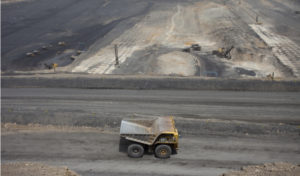
Pingsuo, China. A dump truck travels through a coal mine. Yaorusheng/Shutterstock.com
In The Wall Street Journal, Nathaniel Taplin explains the link between steel and coal companies and the real estate market in China. The commodity industries are heavily indebted, and if the real estate market turns south, they might be worst hit. Taplin writes:
The improvement in steel and coal finances—the two most vulnerable indebted sectors—has been real. Both industries were close to insolvent by late 2015, with aggregate operating earnings just 1.5 times and 1.8 times interest costs, respectively. Two years later, the ratio in both sectors is around 5 times.
Unfortunately, only part of this improvement is due to capacity cuts. The other factor is the enormous, old-school stimulus unleashed in late 2015, which pumped up the real-estate market and commodity demand. The repayment ability of coal and steel firms tends to follow the real-estate investment cycle closely, suggesting that has more to do with improving industrial margins than relatively modest capacity cuts.
China’s financial vulnerability to a real-estate downturn—now starting to unfold again—remains worryingly high. Corporate debt ticked down by a measly 1% of GDP in the first quarter of 2017, according to the Bank for International Settlements, after rising by nearly 50 percentage points over the past five years. Close to 40% of the total is located in the real-estate, construction, mining, and steel sectors, all intimately linked to the property market. Steel firms alone had 4.4 trillion yuan ($665.72 billion) of debt at the end of 2016 (4% of GDP), according to researchers at the ASEAN+3 Macroeconomic Research Office.
Read more here.
